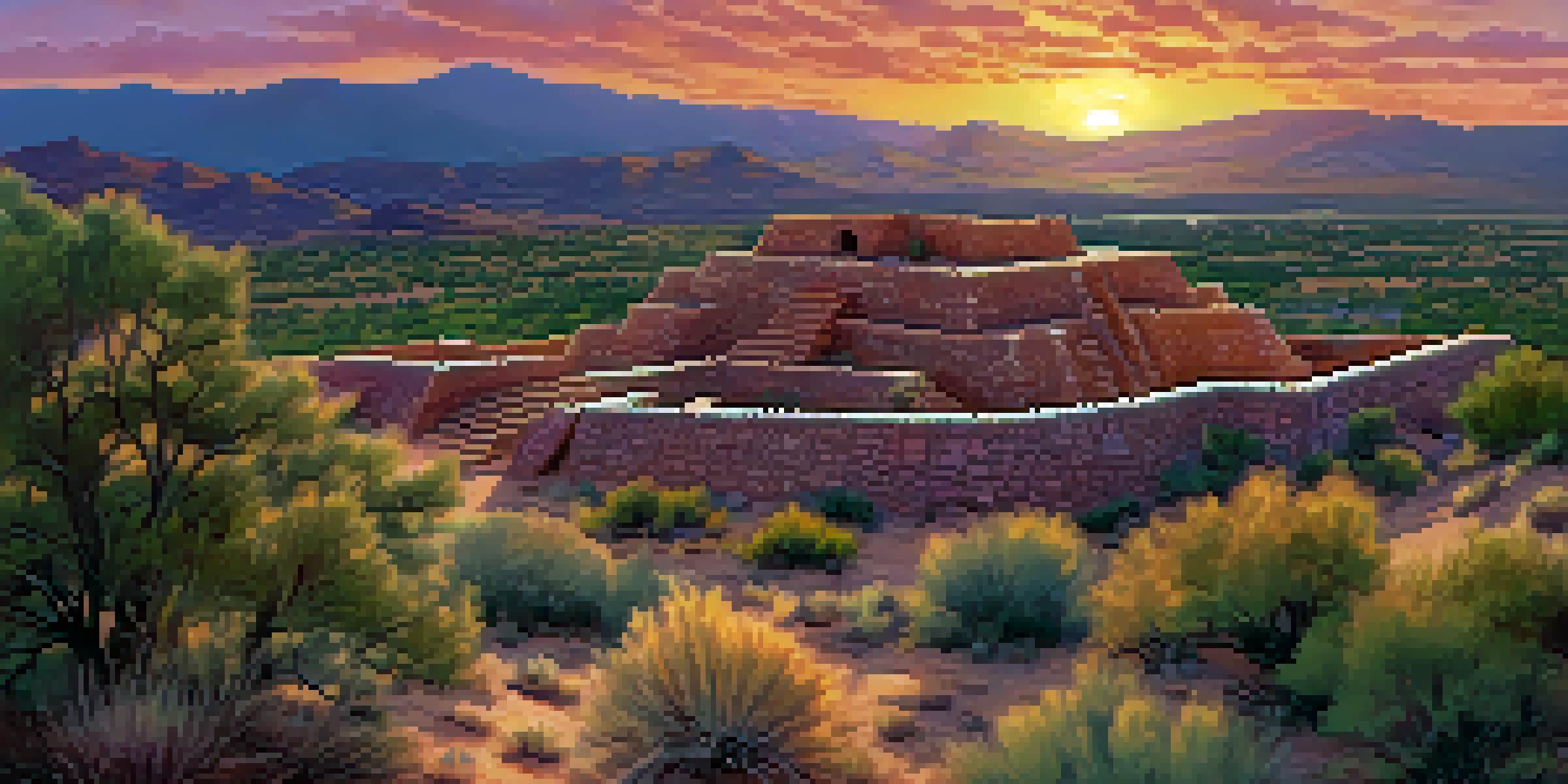A Guide to Arizona's National Historic Landmarks

Introduction to Arizona's Historic Landmarks
Arizona is home to a wealth of National Historic Landmarks that offer a glimpse into the state's rich history and cultural heritage. From ancient Native American sites to iconic structures of the Old West, these landmarks tell the stories of the people and events that shaped Arizona. Visiting these sites not only enriches your understanding of the past but also provides a unique opportunity to experience the beauty of Arizona's diverse landscapes.
The more you know about the past, the better prepared you are for the future.
Each landmark is a piece of the puzzle that makes up Arizona's story, presenting a blend of history, architecture, and natural beauty. These sites are recognized for their exceptional significance, and many are preserved to ensure future generations can appreciate their importance. Whether you're a local or a visitor, exploring these landmarks can be a rewarding adventure.
As we dive deeper into this guide, you'll discover some of the most notable National Historic Landmarks in Arizona, along with tips for exploring them. So, grab your camera and get ready to embark on a journey through time!
Tuzigoot National Monument: A Window to the Sinagua Culture
Tuzigoot National Monument showcases the ruins of a Sinagua village, offering a fascinating glimpse into the lives of the people who inhabited the area over 1,000 years ago. Located near the town of Clarkdale, this site features a hilltop pueblo with stunning views of the Verde Valley. Walking through the ruins, you can almost hear the echoes of daily life as you explore the ancient stone structures.

The monument not only preserves these ruins but also provides insight into the agricultural practices, trade routes, and social structures of the Sinagua people. The visitor center offers informative exhibits that delve deeper into this culture, making it a perfect spot for history buffs and families alike. A stroll along the short trails surrounding the site allows you to appreciate the natural beauty of the area while reflecting on its historical significance.
Explore Arizona's Rich History
Arizona's National Historic Landmarks offer insights into the state's diverse cultural heritage and historical significance.
Visiting Tuzigoot is more than just a trip to an archaeological site; it's an opportunity to connect with the deep-rooted history of Arizona and the Native American cultures that thrived here long ago.
The Mission San Xavier del Bac: A Stunning Architectural Gem
Known as the 'White Dove of the Desert,' Mission San Xavier del Bac is a stunning example of Spanish Colonial architecture located just south of Tucson. Established in the late 17th century, this mission is renowned for its beautiful façade and intricate interior artwork. As you enter, the serene atmosphere and the stunning details of the murals and carvings transport you to a different era.
History is not a burden on the memory but an illumination of the soul.
The mission's history is rich, reflecting the cultural fusion of Native American and Spanish influences in the region. It has survived numerous challenges over the years, including natural disasters and periods of neglect, but restoration efforts have helped preserve its beauty. Visitors can join guided tours to learn more about its history and the role it played in the spread of Christianity among the indigenous people.
Whether you're an architecture enthusiast or simply looking for a peaceful place to visit, San Xavier del Bac offers a unique experience that highlights the artistic and spiritual heritage of Arizona.
The Grand Canyon Railway: A Journey Back in Time
The Grand Canyon Railway is not just a mode of transportation; it’s a historic landmark that connects you to the breathtaking Grand Canyon. Established in the early 20th century, this railway has been transporting passengers to one of the world's natural wonders for over a century. The vintage locomotives and beautifully restored cars make for an unforgettable travel experience, reminiscent of the golden age of rail travel.
As you ride the rails, you'll be treated to stunning views of the Arizona landscape, from lush forests to arid deserts. The journey itself becomes part of the adventure, with entertainment and storytelling that bring the history of the area to life. Passengers often describe the experience as magical, as they anticipate the splendor of the Grand Canyon awaiting them at the end of the line.
Connect with Native American Culture
Sites like Tuzigoot and the Heard Museum provide immersive experiences into the lives and traditions of ancient Native American civilizations.
For those looking to blend history with adventure, a trip on the Grand Canyon Railway is a must. It's not just about reaching a destination; it's about enjoying the ride and the stories that come with it.
The Heard Museum: Celebrating Native American Cultures
The Heard Museum in Phoenix is a vibrant cultural institution dedicated to the arts and history of Native Americans, particularly those of the Southwest. With a collection that spans centuries, the museum offers a comprehensive look at the diverse cultures and traditions of the indigenous peoples of Arizona. From traditional pottery to contemporary art, the exhibits are thoughtfully curated to engage and enlighten visitors.
One of the standout features of the Heard Museum is its focus on storytelling. Through various exhibits and live demonstrations, visitors learn about the significance of art in Native American cultures. The museum also hosts various events throughout the year, including festivals and workshops, that allow for deeper interaction with Native artists and their crafts.
Visiting the Heard Museum is not just an educational experience; it’s an immersive journey into the rich tapestry of Native American life. Whether you're an art lover or a curious traveler, the museum provides a welcoming space to explore and appreciate these vibrant cultures.
The Pueblo Grande Museum: A Glimpse into Ancient Civilizations
Located in Phoenix, the Pueblo Grande Museum is an archaeological site that showcases the ancient Hohokam civilization, which thrived in the region from around 300 AD to 1500 AD. The museum features a fascinating array of artifacts, including pottery, tools, and the remains of an impressive canal system that highlights the ingenuity of the Hohokam people. As you wander through the site, you can see the remnants of their once-thriving community.
The museum also offers educational programs and guided tours that deepen your understanding of Hohokam life and their contributions to modern irrigation practices in Arizona. Interactive exhibits and a reconstructed ball court provide engaging ways to learn about this ancient civilization's culture and sports. It's a great destination for families, students, and anyone interested in archaeology.
Experience Architectural Wonders
Landmarks such as Mission San Xavier del Bac and Taliesin West showcase stunning architectural styles that reflect Arizona's unique cultural fusion.
By visiting the Pueblo Grande Museum, you’re not just observing history; you’re stepping into the shoes of those who lived in this area centuries ago. It’s a captivating way to connect with Arizona's ancient past.
Frank Lloyd Wright’s Taliesin West: Architectural Innovation
Taliesin West, the winter home and architectural school of renowned architect Frank Lloyd Wright, is a masterpiece nestled in the foothills of the McDowell Mountains. Constructed in the 1930s, this site is a testament to Wright's philosophy of organic architecture, which emphasizes harmony between human habitation and the natural world. Visitors can explore the stunning structures and learn about the innovative design techniques that Wright employed.
The site features dramatic terraces, stunning desert views, and unique materials that reflect the surrounding landscape. Guided tours provide insight into Wright's vision and the evolution of his work, making it a must-visit for architecture enthusiasts and anyone who appreciates creativity. The blend of nature and architecture at Taliesin West creates a serene and inspiring atmosphere.

Attending a tour at Taliesin West is more than just a visit; it's an opportunity to engage with the ideas that shaped modern architecture. It’s a place where creativity meets the desert, encouraging visitors to reflect on the relationship between the built environment and the natural world.
Conclusion: Embracing Arizona’s Historical Richness
Exploring Arizona's National Historic Landmarks offers a unique opportunity to connect with the state's diverse history and cultures. Each site tells a story, revealing layers of human experience that contribute to the rich tapestry of Arizona's identity. Whether you're wandering ancient ruins or marveling at architectural masterpieces, these landmarks invite you to reflect on the past while enjoying the present.
As you plan your visits, consider not just the sites themselves but the narratives they hold. Engaging with local guides and participating in educational programs can enhance your experience, providing context and deeper understanding. Arizona's history is not static; it's a living story that continues to unfold.
In embracing these landmarks, you’re not just a visitor; you become a part of Arizona's ongoing narrative, celebrating the cultures and histories that have shaped this beautiful state. So, pack your bags and get ready to explore!